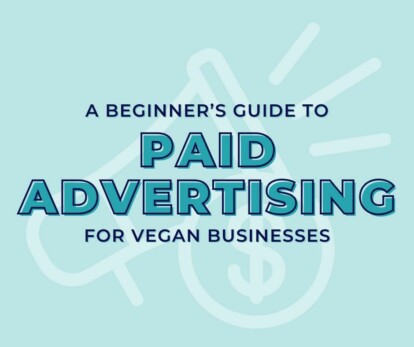Animal resistance: Expressions of agency and free will


If you’re running a vegan business or ethical organisation, especially as a sole trader or with a small team, you might be wondering whether paid ads are worth exploring.
Maybe you’ve seen competitors popping up in your feed, or you’ve noticed your social posts aren’t reaching as many people as they used to. Perhaps growth has slowed, and you’re looking for a way to reach more like-minded customers without relying solely on word of mouth.
Paid advertising might sound expensive or intimidating, but it doesn’t have to be. In fact, with a small, well-planned budget, you can start reaching more of the right people, faster.
This guide will help you understand the basics of online paid advertising, compare the main platforms, and explore whether it’s a good fit for your business, even on a modest budget.
Paid advertising is a marketing model where brands pay to be able to show ads to their target audience. Although TV and radio adverts technically fit in this category, this blog is about internet-based advertising.
Online ads typically work on an auction-style basis where advertisers bid for ad space on their chosen platform (e.g. Google, Facebook). Ads targeting keywords with high search volumes and high levels of competition may be more expensive to run than ads targeting lower competition niche keywords, but the costs depend on the type of ad, audience, ad quality, user engagement, and other factors.
Semrush has put together a great beginner’s guide to paid advertising that you might find helpful.
What you pay for advertising will depend on the model. You might need to pay:
Paid advertising services allow you to set a cap on your budget. For example, you could set a budget of £10 per day for Facebook ads, and once there have been £10 worth of impressions, the ad won’t display again until your budget resets on the next day.
Let’s start with the basics. Why even bother with paid ads?
For many small businesses, the default approach is organic marketing. Usually, this involves creating a website with some basic SEO, posting on social media, relying on word of mouth, or sharing stories through your newsletter.
While organic marketing is important, the harsh reality is that algorithms can change, throttling your visibility and making organic reach unpredictable. This means that growth through word of mouth, while beautiful and effective, can be slow.
Paid ads give you control. They allow you to:
They’re not about shouting louder. They’re about being seen by the right people, at the right time, in a way that supports your mission.
And when you’re doing it on your own, or with a team of one or two, that kind of precision really matters in terms of protecting your time, money, and energy.
Before you invest a penny, let’s explore your platform options:
Google Ads is Google’s advertising platform that lets you reach people right when they’re searching for something online (or even when they’re not, depending on the type of ad you choose).
There are two main parts to the Google Ads universe:
These are the classic text ads that show up on the Google Search results page, usually at the very top (above the organic listings) or at the bottom.
They appear when someone types in keywords you’ve selected, so you’re reaching people who are actively looking for what you offer.
For example, if someone types “vegan nutritionist near me” and you’ve bid on that keyword, your ad could appear at the top of their results.
These ads can also appear on other Google-owned properties like:
B) The Google Display Network (GDN)
This is a massive collection of websites, mobile apps, and YouTube videos where Google can place your visual ads (like banners or responsive image ads).
Unlike Search Ads, these aren’t based on what someone just typed – they’re based on:
These ads are great for raising awareness and staying visible, but they’re usually not as effective for getting instant purchases because people aren’t in “searching” mode.
Other Google ad types include:
Best for: Reaching people who are already searching for what you sell (especially through Search and Shopping ads).
Pros:
Cons:
To learn more about Google Ads, try these resources:
Meta’s ad platform lets you run campaigns across Facebook, Instagram, Messenger, and WhatsApp – all from one dashboard. Unlike Google, where you’re targeting what people are searching for, Meta Ads target who people are, based on their interests, behaviours, demographics, and past activity.
This makes Meta Ads particularly powerful for reaching new audiences who don’t yet know about you but would want to, and for gently reminding people who’ve engaged with your brand to come back.
Ad types on Meta include:
Best for: Building brand awareness and trust, telling your story visually, and retargeting warm leads
Pros:
Cons:
To learn more about Meta Ads, try these resources:
TikTok isn’t just for dances and Gen Z anymore, although it’s still skewed young and fast-moving. If you enjoy creating short-form videos and have a message that can be delivered with energy, authenticity, or a bit of humour, TikTok is worth exploring (you can find our guide to building a TikTok audience for your ethical business here).
The platform is heavily algorithm-driven, so organic reach can be high, but paid ads help you guarantee visibility, especially to people with specific interests.
Ad types on TikTok include:
Best for: Capturing attention through playful or educational short videos, growing awareness with a younger audience, and humanising your brand through authentic content
Pros:
Cons:
To learn more about TikTok Ads, try these resources:
Pinterest isn’t just for recipes and wedding boards; it’s a powerful discovery tool for ethical products and lifestyle inspiration that operates more like a visual search engine than a social platform.
People use it to plan, dream, and discover. That makes it perfect for evergreen content and products that align with aspirational or lifestyle goals, so think recipes, eco home goods, plant-based fashion, and cruelty-free self-care routines.
Ad Types on Pinterest include:
Best for: E-commerce stores with a lifestyle angle or businesses with strong visual content (DIY, recipes, skincare, homeware), as well as driving long-term traffic (pins can resurface weeks or months later)
Pros:
Cons:
To learn more about Pinterest Ads, try these resources:
You might also want to explore paid advertising opportunities on platforms such as:
Whichever platform you advertise on, you’ll find there are acronyms to understand, which can be daunting at first! You don’t need to become an expert overnight, but knowing the key acronyms – and, most importantly, the numbers to which they refer – can help you figure out what’s working and what’s not.
Here are the most useful terms to know and track:
If you’re building awareness, you want high reach and CTR. If you’re selling a product or service, then the CPA and ROAS are your guiding stars.
You genuinely don’t need thousands of pounds to run a successful paid ad campaign. Most of the platforms we’ve mentioned above allow you to be incredibly specific about who you target, which means you should be able to reach the right audience with a relatively small spend.
1. Start with a clear, measurable goal
One campaign = one purpose. Do you want to get email signups, to sell five units of a new product, or drive traffic to a blog post? It’s vital to be specific, so you can measure success clearly.
2. Focus on targeting
The more precise you are about the audience you want to reach, the further your budget will stretch. You can:
Avoid “boosting” posts blindly, as it’s usually not the best use of your spend.
3. Use existing content as your test bed
If a Reel or post has done well organically, it’s a great candidate for a paid ad. The groundwork is already done.
4. A/B test with small spends
Run two variations of the same ad with different headlines or images. After a few days, turn off the underperformer.
5. Retarget your warm audience
This is your most cost-effective tactic. Show ads only to people who’ve:
These people are already halfway there – they just need a gentle nudge!
6. Optimise your ad landing page
If people click but don’t buy, the issue might not be the ad but the page they land on. Check the landing page to make sure:
7. Cap your budget
One of the easiest ways to stay in control is to set a daily or lifetime budget cap for your campaigns. Most platforms let you do this with just a few clicks. That way, you can experiment without the fear of overspending. Start small – £5-£10 a day is enough to gather useful data without risking too much. Once you know what’s working, you can scale up gradually.
8. Tap into local and seasonal trends
Use your ad targeting to focus on your local area, especially if you offer services or sell at events. Geo-targeting your town, city, or region reduces waste and can make your ads feel more relevant.
You can also run seasonal or event-based campaigns, like promoting ethical travel products, Veganuary specials, or festive hampers. This helps your ads feel timely and taps into people’s natural buying rhythms.
9. Use the free analytics tools
Every ad platform comes with its own built-in analytics dashboard, and they’re more helpful than they might seem at first glance. Use them to check which ads are performing best, where your money’s going, and how people are responding.
Even better, tools like Meta’s Ads Manager, Google Ads Dashboard, and Pinterest Analytics often suggest what to tweak for better results.
Now that you know where to advertise, let’s talk about what success looks like. There’s no one-size-fits-all answer unfortunately. Below, you’ll see general benchmarks drawn from cross-industry data.
Your results may vary depending on your product, audience, and ad goals. Use these as a starting point and compare them to your own past performance wherever possible.
If you’re hitting below these, it doesn’t necessarily mean failure, but it might mean that it’s time to tweak your ad, audience, or landing page.
Check in weekly on active campaigns and review monthly to spot trends.
Paid advertising doesn’t need to feel overwhelming, manipulative, or out of reach. When done with care and strategy, it can simply be a tool to help your work reach the people it’s meant for.
It’s OK to not run paid ads right now, of course, especially if you’re still finding your audience, your website isn’t ready to convert, or you don’t yet have a clear offer or call to action. Ads should amplify what’s already working, not fix what’s broken or yet to be done.
But if you are ready to explore the potential of paid ads, our advice is to start small and focus on one platform. Set a clear goal, track what happens, cap your budget, and then learn and adjust.
You don’t have to compete with huge brands. You just have to connect with the people who care, and paid ads, used well, can help you do exactly that.